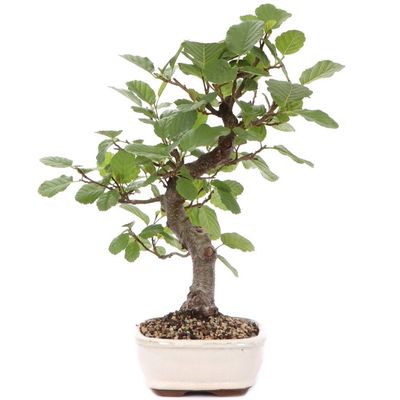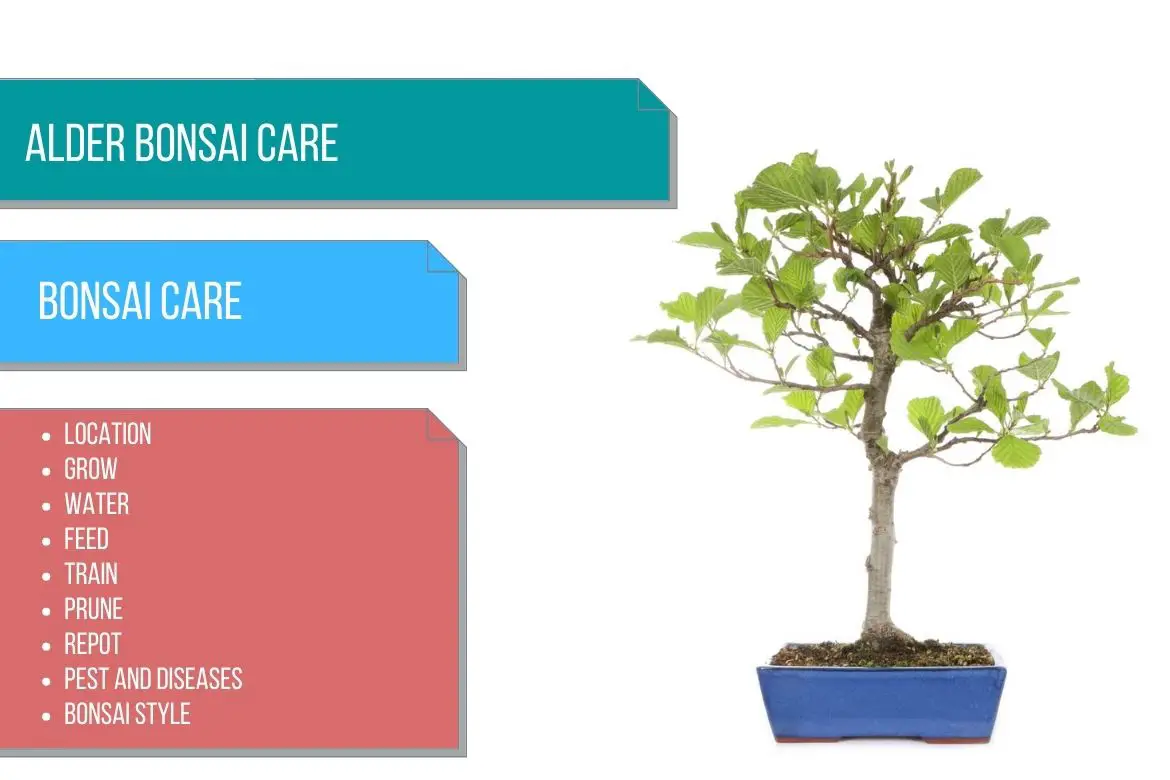
Alder
(Alnus)
Country of Origin : Europe, western Asia, Northern Africa
Bonsai Styles : Formal upright, Informal Upright, group,
Zone : 4 – 9
Alder is a hardy deciduous tree. It has petiolate, alternate, and rounded leaves. The leaves are particularly sticky when young.
The bark of the tree is dark gray and fissured.
Unlike many other trees, alders are particularly well adapted to growing in wet soils near the banks of rivers and lakes. It is a peculiar characteristic of wood that it hardens when it comes into contact with water, and that it is particularly resistant to water.
The flowers of this plant are unisexual, with the males arranged in drooping catkins appearing before the leaves and the females arranged in oval cones that look like small pine cones.
Can you bonsai an alder tree?
Yes. Alder trees are suitable for making an outdoor bonsai tree. Alders are easy to train as a bonsai, very adaptable and easy to prune and shape. They make excellent bonsai, although their leaves can look out of proportion to the tree. Although alder bonsai trees are more popular in Europe, they are slowly gaining some popularity among some bonsai growers in North America.
There are almost 35 species in the Alnus genus. However, the following two species of alder are commonly used to make bonsai:
- Alnus glutinosa: Also known as common alder or black alder. This tree has dark green ovate leaves. It produces yellowish-brown catkins.
- Alnus cordata: Also known as Italian alder. This tree has shiny, dark green, heart-shaped leaves. Similar to A. glutinosa, this tree also produces yellowish-brown catkins.
Read more about other bonsai trees species in : Types of bonsai tree
Best location to keep Alder Bonsai tree
Alder bonsai trees can be placed in full sun in summer. However, put them in partial shade when the weather is too hot. These trees thrive in humid conditions.
These trees winter hardy and also hardy on benches. Move the bonsai container to a protected shed or green house at the time of prolonged cold weather.
These trees can tolerate temperatures as low as -65° F (-54° C) in the wild. However, do not expose this tree to temperatures below freezing for prolonged periods of time when grown in bonsai container.
IMP: Refer to do bonsai trees need sunlight for more indoor and outdoor bonsai location ideas. Also, refer sunlight requirements for indoor plants for more indoor gardening ideas.
Propagation of alder tree
Common alder can be propagated using seeds. Soak the seeds in water for 1-2 days. Mix the seeds with horticultural sand in a plastic bag. Keep this bag in the fridge for a month. Sow the seeds in the spring. Keep watering the seed tray. Moisture increases the speed of germination.
Alternatively, hardwood cuttings can be taken during dormancy, after leaves have fallen or before buds begin to form.
Watering Alder Bonsai tree
You should water both of these alder species freely throughout the growing season.
This tree can also tolerate wet soil as this tree is often found near water bodies in the wild. However, this does not mean that you can keep the soil waterlogged at all times or else it will cause rotting.
During winter, keep the compost just moist.
Read watering bonsai tree for more details.
Wiring Alder Bonsai tree
Wire an alder bonsai tree in spring and early summer.
Because new growth is usually too tender, it is a good idea to wire the previous year’s growth, which will have had time to harden.
It is important to remove the wires as soon as the branches have settled in position, which may take just a couple of months.
Alder can be easily marked by wiring. Although you have taken all precautions, if your bonsai is still scarred because of the wires, do not worry. Light scars are not necessarily bad for the tree. It adds a unique character to the bonsai tree.
Read : Detailed guide on How to wire a bonsai. This guide will also tell you what precautions to take while wiring.
Pruning Alder Bonsai tree
When to prune alder bonsai tree?
How to prune alder bonsai tree?
Alder trees are vigorous growers. Hence, all through the growing season, prune the new shoots back to one-third of their length (back to two leaves). This will help in keeping the bonsai tree in shape.
In order to maintain the structure of the plant, prune back to old wood in the spring. As soon as new buds are about to burst on the plant in the spring at repotting time, you should do some heavy pruning.
Pinching out the tips of the new shoots on a weekly basis in summer will keep the tree compact and promote short internodes.
In order to reduce the size of the leaves, perform complete defoliation every three years.
Read how to prune a bonsai to know about the right technique of pruning and more about defoliating a bonsai tree.
Repotting Alder Bonsai tree
When to repot alder tree bonsai?
Alder is a vigorously growing plant, so it will require annual repotting. You can repot Alder bonsai in early spring.
You can prune almost half of the rootball at the time of root pruning.
They also aren’t very particular about the compost that should be used to repot them. However they dislike lime.
Make sure that you use a deep pot for alder bonsai.
You can use a basic free-draining bonsai soil mix as a potting soil.
Please check out how to repot a bonsai to know everything about repotting and root pruning a bonsai.
Must Read: Bonsai Soil Recipes
Must read : Choosing the right bonsai container
Feeding Alder Bonsai tree
From early spring to late summer, you should apply a general fertilizer once a month. Use a fertilizer that is low in nitrogen.
Read more about bonsai fertilizer and its application.
Diseases and pest of Alder Bonsai tree
The alder bonsai tree is occasionally infested with aphids and scale insects. You can apply a systemic insecticide.
There are also a few fungal diseases that can attack these plants such as bracket rot and leaf spot fungus. Apply the appropriate fungicide. Ensure that all affected areas are cut back to healthy wood, and the pruning wounds are sealed. Burn the infected parts.
Our comprehensive guide: How to identify and treat bonsai pests and diseases is a great resource for you to see all the organic and inorganic remedies you can use.
In spite of the fact that they prefer moist soil, if they stand in waterlogged soil for too long they will suffer from root rot, a disease that can be fatal.
Branches can suffer from die-back from time to time; if this is the case, prune them back hard to the healthy tissue.

